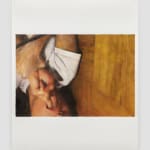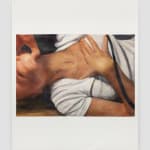
Bacchae (The dangerous one), 2019
Oil and wax on paper
40 x 47 inches each

Bacchae (The dangerous one), 2019
Oil and wax on paper
40 x 47 inches each

Bacchae (The dangerous one), 2019
Oil and wax on paper
40 x 47 inches each

Bacchae (The dangerous one), 2019
Oil and wax on paper
40 x 47 inches each
Regina Parra
Further images
Of the nine paintings in the exhibition of Regina Parra, at Galeria Millan, in São Paulo, eight are female bodies in cutouts that leave us wondering if they are suffering bodies or orgasmic bodies.
Title of the exhibition: “Bacante”. The bacchantes, followers of the cult of Dionysus, who of ciated in orgiastic ceremonies, were, as we know, well tolerated in ancient Greece (Euripides set up “The Bacchantes” in 405 BC). When, 200 years later, the cult of Dionysius arrived in Rome, the romans could not bear it: it was unbearable to see those groups with tambourines and flutes, dancing and fucking, at the corners of the city.
In short, the Bacchantes were the first and perhaps the only religious group forbidden and persecuted in Rome. They are the ancestors of the tempting female body that was hated and rejected (“the door through which evil enters,” Tertullian said) from the earliest centuries of Christianity. They are the ancestors of women who were burned and hanged in the middle of the Renaissance for “witchcraft.”
Parra’s paintings are a perfect and moving vision of the female body that is bequeathed to us by this story. A suffering body that never ceases to be the prototype of joy. A body that must be covered and uncovered, restrained and set free to ward off temptation and to be tempted. A body that fascinates and frightens, that we love free and want to dominate.
Let no one worry excessively: we build our eroticism around these contradictions. And we will continue fantasizing like this: the feminine will not change places so soon.
But what could change if we stopped pursuing the women that assume their own desire.
Review by Contardo Calligaris, writer, for Folha de Sao Paulo newspaper, March, 2019.
Exhibitions
Bacchae (2019) at Galeria Millan, Sao Paulo, Brazil





